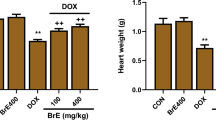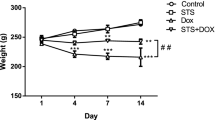Abstract
Despite the effectiveness of doxorubicin (DOX) in the management of a wide range of cancers, a major challenge is its cardio-toxic effect. Oxidative stress, inflammation, and apoptosis are major pathways for the cardiotoxic effect of DOX. On the other hand, acetate reportedly exerts antioxidant, anti-inflammatory, and anti-apoptotic activities. This particular research assessed the impact of acetate on cardiotoxicity induced by DOX. Mechanistically, acetate dramatically inhibited DOX-induced upregulation of xanthine oxidase and uric acid pathway as well as downregulation of Nrf2/HO-1 signaling and its upstream proteins (reduced glutathione peroxidase, superoxide dismutase, glutathione-S-transferase, glutathione, and catalase, glutathione reductase). In addition, acetate markedly attenuated DOX-driven rise inTNF-α, NFkB IL-6 and IL-1β expression, and myeloperoxidase activity. Furthermore, acetate significantly ameliorated DOX-led suppression of Bcl-2 and Ca2+-ATPase activity and upregulation of Bax, caspase 3, and caspase 9 actions. Improved body weight, heart structural integrity, and cardiac function as depicted by cardiac injury markers convoyed these cascades of events. Summarily, the present study demonstrated that acetate protects against DOX-induced cardiotoxicity by upregulating Nrf2/HO-1 signaling and downregulating NFkB-mediated activation of Bax/Bcl-2 and caspase signaling.








Similar content being viewed by others
Data availability
The data used to support the findings of the present study are available from the corresponding author upon request.
References
Akhigbe R, Ajayi A (2020) Testicular toxicity following chronic codeine administration is via oxidative DNA damage and up-regulation of NO/TNF-α and caspase 3 activities. PLoS ONE 15(3):e0224052
Akhigbe RE, Ajayi LO, Adelakun AA, Olorunnisola OS, Ajayi AF (2020) Codeine-induced hepatic injury is via oxido-inflammatory damage and caspase-3-mediated apoptosis. Mol Biol Rep 47:9521–9530
Akhigbe RE, Ajayi LO, Ajayi AF (2021a) Codeine exerts cardiorenal injury via upregulation of adenine deaminase/xanthine oxidase and caspase 3 signaling. Life Sci 15(273):118717
Akhigbe RE, Hamed MA, Aremu AO (2021b) HAART exacerbates testicular damage and impaired spermatogenesis in anti-Koch-treated rats via dysregulation of lactate transport and glutathione content. Reprod Toxicol 103:96–107
Akhigbe RE (2014) Discordant results in plant toxicity studies in Africa: attempt of standardization. In: Toxicological survey of African medicinal plants. Elsevier pp 53–61
Alexieva B, Sainova I, Pavlova V, Markova T, Valkova I, Nikolova E (2014) Insights into mechanisms of doxorubicin cardiotoxicity. J Phys Pharm Adv 4:342–348
Antonopoulos C, Russo HM, El Sanadi C, Martin BN, Li X, Kaiser WJ, Mocarski ES, Dubyak GR (2015) Caspase 8 as an effector and regulator of NLRP3 inflammasome signaling. J Biol Chem 290(33):20167–20184
Bekyarova G, Tzaneva M, Hristova M (2015) Melatonin protects against burn-induced hepatic oxidative injury by inducing HO-1 via the Nrf2 pathway. Vet Med 60(11)
Beutler E, Duron O, Kelly BM (1963) Improved method for the determination of blood glutathione. J Lab Clin Med 61:882–888
Bryan HK, Olayanju A, Goldring CE, Park BK (2013) The Nrf2 cell defence pathway: Keap1-dependent and-independent mechanisms of regulation. Biochem Pharmacol 85(6):705–717
Clausen T, Van Hardeveld C, Everts ME (1991) Significance of cation transport in control of energy metabolism and thermogenesis. Physiol Rev 71:733–774
Davignon J-L, Hayder M, Baron M, Boyer J-F, Constantin A, Apparailly F, Poupot R, Cantagrel A (2012) Targeting monocytes/macrophages in the treatment of rheumatoid arthritis. Rheumatology 52:590–598
de Lima Junior EA, Yamashita AS, Pimentel GD, De Sousa LG, Santos RV, Gonçalves CL, Streck EL, de Lira FS, Rosa Neto JC (2016) Doxorubicin caused severe hyperglycaemia and insulin resistance, mediated by inhibition in AMPk signalling in skeletal muscle. J Cachexia Sarcopenia Muscle 7(5):615–625
Dennery PA (2014) Signaling function of heme oxygenase proteins. Antioxid Redox Signal 20(11):1743–1753
Elmore S (2007) Apoptosis: a review of programmed cell death. Toxicol Pathol 35:495–516
El-Sayed EM, Mansour AM, El-Sawy WS (2017) Protective effect of proanthocyanidins against doxorubicin-induced nephrotoxicity in rats. J Biochem Mol Toxicol 31:e21965
Euler HV, Josephson K (1972) Uber katalase. I European J Org Chem 452:158–181
Fridovich I, Misra HP (1972) The role of superoxide anion in the autooxidation of epinephrine and a simple assay for superoxide dismutase. J Biol Chem 247:3170–3175
Fuller W, Eaton P, Bell JR (2004) Ischemia-induced phosphorylation of phospholemman directly activates rat cardiac Na/K ATPase. FASEB J 18:197–199
Habig WH, Pabst MJ, Jakoby WB (1974) Glutathione-S-transferases The first enzymatic step in mercapturic acid formation. J Biol Chem 249(22):7130–9
Hamed MA, Akhigbe RE, Aremu AO, Odetayo AF (2022a) Zinc normalizes hepatic lipid handling via modulation of ADA/XO/UA pathway and caspase 3 signaling in highly active antiretroviral therapy-treated Wistar rats. Chem Biol Interact 1(368):110233
Hamed MA, Akhigbe TM, Akhigbe RE, Aremu AO, Oyedokun PA, Gbadamosi JA, Anifowose PE, Adewole MA, Aboyeji OO, Yisau HO, Tajudeen GO, Titiloye MM, Ayinla NF, Ajayi AF (2022b) Glutamine restores testicular glutathione-dependent antioxidant defense and upregulates NO/cGMP signaling in sleep deprivation-induced reproductive dysfunction in rats. Biomed Pharmacother 148:112765
Holopainen T, Räsänen M, Anisimov A, Tuomainen T, Zheng W, Tvorogov D, Hulme JJ, Andersson LC, Cenni B, Tavi P (2015) Endothelial Bmx tyrosine kinase activity is essential for myocardial hypertrophy and remodelling. Proc Natl Acad Sci USA 112:13063–13068
Horn HD, Burns FH (1965). In: Bergmeyer H-U (ed) Methods of enzymatic analysis. Academic Press, Cambridge, MA, pp 875–879
Ismail MB, Rajendran P, AbuZahra HM, Veeraraghavan VP (2021) Mangiferin inhibits apoptosis in doxorubicin-induced vascular endothelial cells via the Nrf2 signaling pathway. Int J Mol Sci 22(8):4259
Kannan K, Jain SK (2000) Oxidative stress and apoptosis. Pathophysiology 7:153–163
Klippstein R, Bansal SS, Al-Jamal KT (2016) Doxorubicin enhances curcumin’s cytotoxicity in human prostate cancer cells in vitro by enhancing its cellular uptake. Int J Pharm 514:169–175
Kuznetsov AV, Margreiter R, Amberger A, Saks V, Grimm M (2011) Changes in mitochondrial redox state, membrane potential and calcium precede mitochondrial dysfunction in doxorubicin-induced cell death. Biochim Biophys Acta 1813:1144–1152
Kwatra M, Kumar V, Jangra A, Mishra M, Ahmed S, Ghosh P et al (2016) Ameliorative effect of naringin against doxorubicin-induced acute cardiac toxicity in rats. Pharm Biol 54:637–647
Li S, Wang W, Niu T, Wang H, Li B, Shao L, Lai Y, Li H, Janicki JS, Wang XL (2014) Nrf2 deficiency exaggerates doxorubicin-induced cardiotoxicity and cardiac dysfunction. Oxid Med Cell Longev 2014:748524
Ma Y, Yang L, Ma J, Lu L, Wang X, Ren J (1863) Yang J 2017 Rutin attenuates doxorubicin-induced cardiotoxicity via regulating autophagy and apoptosis. Biochimica et Biophysica Acta (BBA) Molecular Basis of Disease. 8:1904–11
Mantawy EM, Esmat A, El-Bakly WM, ElDin RAS, El-Demerdash E (2017) Mechanistic clues to the protective effect of chrysin against doxorubicin-induced cardiomyopathy: Plausible roles of p53. MAPK and AKT Pathways Sci Rep 7:4795
McGowan JV, Chung R, Maulik A, Piotrowska I, Walker JM, Yellon DM (2017) Anthracycline chemotherapy and cardiotoxicity. Cardiovasc Drugs Ther 31:63–75
Menna P, Salvatorelli E, Minotti G (2010) Anthracycline degradation in cardiomyocytes: a journey to oxidative survival. Chem Res Toxicol 48:1334–40
Müller-Ehmsen J, McDonough AA, Farley R (2002) Sodium pump isoform expression in heart failure: implication for treatment. Basic Res Cardiol 97:I25–I30
Nna VU, Abu Bakar AB, Ahmad A, Eleazu CO, Mohamed M (2019) Oxidative stress, NF-κB-mediated inflammation and apoptosis in the testes of streptozotocin-induced diabetic rats: combined protective effects of Malaysian propolis and metformin. Antioxidants 8:465
Olaniyi KS, Akintayo CO, Oniyide AA, Omoaghe AO, Oyeleke MB, Fafure AA (2021) Acetate supplementation restores testicular function by modulating Nrf2/PPAR-γ in high fat diet-induced obesity in Wistar rats. J Diabetes Metab Disord 20:1685–1696
Origassa CS, Câmara NO (2013) Cytoprotective role of heme oxygenase-1 and heme degradation derived end products in liver injury. World J Hepatol 5(10):541
Oyagbemi AA, Omobowale TO, Olopade JO, Farombi EO (2017) Kolaviron and Garcinia kola attenuate doxorubicin-induced cardiotoxicity in Wistar rats. J Complement Integr Med. 15(1):/j/jcim.2018.15.issue-1/jcim-2016–0168/jcim-2016–0168.xml. https://doi.org/10.1515/jcim-2016-0168
Perandones CE, Illera VA, Peckham D, Stunz LL, Ashman RF (1993) Regulation of apoptosis in vitro in mature murine spleen T cells. J Immunol 151(7):3521–3529
Pfzer (2019) Doxorubicin hydrochloride—Doxorubicin hydrochloride injection, solution. Accessed 02/12/2020; http://labeling.pfzer.com/showlabeling.aspx?id=530
Renu K, Abilash VG, Tirupathi PPS, Sankarganesh A (2018) Molecular mechanism of doxorubicin-induced cardiomyopathy – an update. Eur J Pharmacol 818:241–253
Rotruck JT, Pope AL, Ganther HE, Swanson AB, Hafeman DG, Hoekstra WG (1973) Selenium: biochemical role as a component of glutathione peroxidase. Science 179(4073):588–590
Sakahira H, Enari M, Nagata S (1998) Cleavage of CAD inhibitor in CAD activation and DNA degradation during apoptosis. Nature 391:96–99
Sharifi S, Barar J, Hejazi MS, Samadi N (2015) Doxorubicin changes Bax/Bcl-xL ratio, caspase-8 and 9 in breast cancer cells. Adv Pharm Bull 5(3):351–359
Sinha N, Dabla PK (2015) Oxidative stress and antioxidants in hypertension-a current review. Curr Hypertens Rev 11(2):132–142
Sutariya B, Saraf M (2018) α-asarone reduce proteinuria by restoring antioxidant enzymes activities and regulating necrosis factor κB signaling pathway in doxorubicin-induced nephrotic syndrome. Biomed Pharmacother 98:318–324
Tavora B, Reynolds LE, Batista S, Demircioglu F, Fernandez I, Lechertier T, Lees DM, Wong P-P, Alexopoulou A, Elia G (2014) Endothelial-cell FAK targeting sensitizes tumours to DNA-damaging therapy. Nature 514:112–116
Therien AG, Goldshleger R, Karlish SJ, Blostein R (1997) Tissuespecifc distribution and modulatory role of the gamma subunit of the Na, K-ATPase. J Biol Chem 272:32628–32634
Ujah GA, Nna VU, Suleiman JB, Eleazu C, Nwokocha C, Rebene JA, Imowo MU, Obi EO, Amachree C, Udechukwu EC, Mohamed M (2021) Tert-butylhydroquinone attenuates doxorubicin-induced dysregulation of testicular cytoprotective and steroidogenic genes, and improves spermatogenesis in rats. Sci Rep 11(1):1–3
Usman TO, Adeyanju OA, Areola ED, Badmus OO, Oyeyipo IP, Olaniyi KS, Oyabambi AO, Olatunji LA (2021) Acetate causes renoprotection like androgen and mineralocorticoid receptors blockade in testosterone-exposed pregnant rats. Mol Cell Biochem 476(4):1861–1870
Warren CF, Wong-Brown MW, Bowden NA (2019) BCL-2 family isoforms in apoptosis and cancer. Cell Death Dis 10:1–12
Weinreb M, Rodan GA, Thompson DD (1991) Depression of osteoblastic activity in immobilized limbs of suckling rats. J Bone Miner Res 6:725–731
Wu T, Li J, Li Y, Song H (2017) Antioxidant and hepatoprotective effect of swertiamarin on carbon tetrachloride-induced hepatotoxicity via the Nrf2/HO-1 pathway. Cell Physiol Biochem 41(6):2242–2254
Xun P, Zhou C, Huang X, Huang Z, Yu W, Yang Y, Li T, Huang J, Wu Y, Lin H (2022) Effects of dietary sodium acetate on growth performance, fillet quality, plasma biochemistry, and immune function of juvenile golden pompano (Trachinotus ovatus). Aquac Nutr 2022:1–1
Funding
This study was self-funded.
Author information
Authors and Affiliations
Contributions
Conceptualization and design: ADH, OOO, HMA, and ARE. Data analysis: ADH, OOO, HMA, and ARE. Funding acquisition: ADH, OOO, HMA, and ARE. Investigation: ADH, OOO, HMA, ARE. Methodology: ADH, OOO, HMA, ARE. Project administration: ADH, OOO, HMA, and ARE. Supervision: ADH, OOO, HMA, and ARE. Validation: ADH, OOO, HMA, and ARE. Writing—original draft: ADH, OOO, HMA, and ARE. Writing—review and editing and final approval: ADH, OOO, HMA, and ARE. The authors declare that all data were generated in-house and that no paper mill was used.
Corresponding author
Ethics declarations
Ethical approval
The research was approved by the institution’s Ethics Review Committee.
Competing interests
The authors declare no competing interests.
Additional information
Publisher's note
Springer Nature remains neutral with regard to jurisdictional claims in published maps and institutional affiliations.
Rights and permissions
Springer Nature or its licensor (e.g. a society or other partner) holds exclusive rights to this article under a publishing agreement with the author(s) or other rightsholder(s); author self-archiving of the accepted manuscript version of this article is solely governed by the terms of such publishing agreement and applicable law.
About this article
Cite this article
Adeyemi, D.H., Obembe, O.O., Hamed, M.A. et al. Sodium acetate ameliorates doxorubicin-induced cardiac injury via upregulation of Nrf2/HO-1 signaling and downregulation of NFkB-mediated apoptotic signaling in Wistar rats. Naunyn-Schmiedeberg's Arch Pharmacol 397, 423–435 (2024). https://doi.org/10.1007/s00210-023-02620-4
Received:
Accepted:
Published:
Issue Date:
DOI: https://doi.org/10.1007/s00210-023-02620-4




